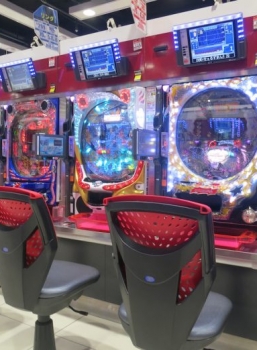Pachinko is one of Japan’s most famous mechanical games; it can be used both as a recreational and gambling device. Pachinko parlors are often regarded as the Japanese equivalent of casinos. In fact, the décor, ambiance and gaming policies in Pachinko parlors quite resemble western casinos.
The widespread appeal of Pachinko originates from the high customizability of the machine; they can be tweaked in a variety of ways, ensuring constant entertainment.
Pachinko Parlor Machines
However, there exists a certain stigma around Pachinko machines, as cash-gambling is illegal in Japan. To go around this problem, Pachinko Parlors in Japan now ensure the Pachinko balls won in games cannot be exchanged for money directly at the parlor. Instead, Pachinko ball winnings will earn you prizes or tokens, which can only be exchanged for money at a premise entirely separate from the parlor. These strict regulations have however never dampened the mood of avid players. In fact, it has nurtured the individuality of the game and motivated many to know its roots.
Understanding the History of Pachinko in Japan
The rich history of this game is thoroughly captivating. Over 20 years ago, the Japanese Pachinko market was valued at ¥30 trillion, or almost $300 Billion. It is surprising that this industry, which accumulates more revenue than the Las Vegas, Macau and Singapore gambling industries combined, originated from a simple children’s game.
Pachinko Machines were built in the mid-1920’s under the name of “Corinth game”. This initial name was derived from the famous American “Corinthian Bagatelle”. It is also said that the “Japanese Billiards” may have served as a somewhat distant inspiration for the game’s making.
Pachinko Machines in Pachinko Parlor
In Nagoya, Japan, during the 1930’s, Pachinko became an adult game due to its ease of use for gambling purposes. By 1940, Pachinko had spread all over Japan. However, World War II saw all Pachinko parlors close down. Though this unexpected ban lasted a few years, by the end of the 1940’s, Pachinko was back and popular as ever. In 1948, Nagoya opened its first officially commercial Pachinko Parlor. Back then, Pachinko machines operated mechanically. Bells communicated the different states of the machine, whereas electricity was used as signals or to suggest problems – for instance when the machine was out of balls. A flipper hurled the balls, and the level at which the flipper was used controlled the speed of the launching.
However, by the 1980’s, Pachinko machines began to feature more electronic operations. They are now fully automatic, and like slot machines, require only the insertion of cash or cards into the machine to receive a number of balls to play with. Pulling the lever on the Pachinko machine hurls the ball from a ball tray. The balls are then faced, on their descent, with a variety of obstacles until they drop to the bottom of the machine screen.
While this modern, highly automated version of Pachinko has revolutionized the Japanese gambling market, many Pachinko connoisseurs and collectors all over the world still avidly seek out the original, hand-crafted Pachinko machines. They may very well be regarded as a fascinating piece of Japanese cultural heritage.
